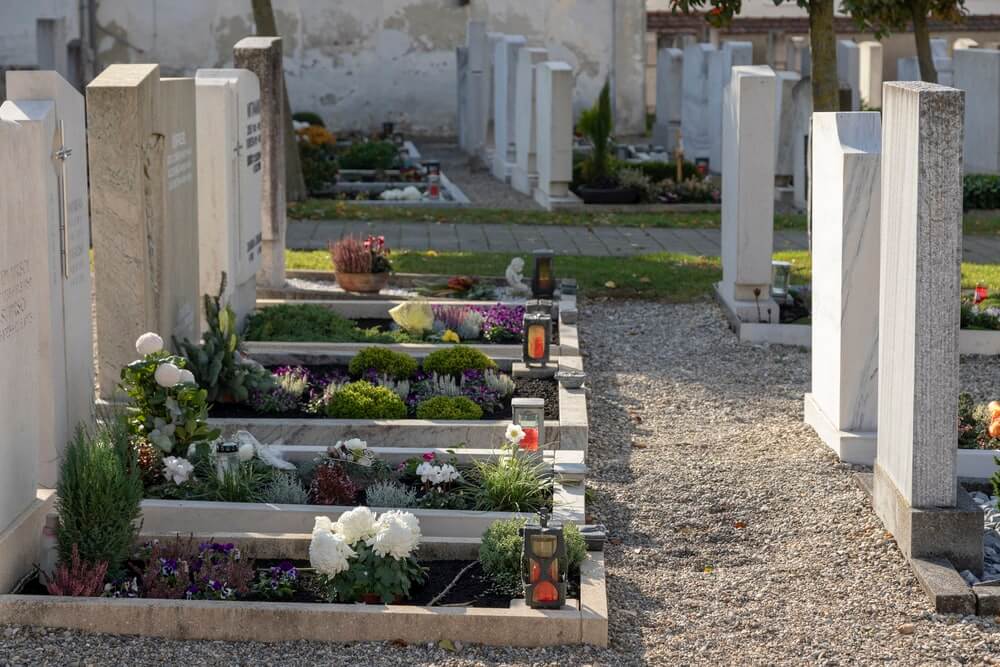Here’s all you need to know about funeral traditions in Japan the Japanese culture of death and dying and what they do during this time!
Attending a funeral in Japan? Respectful etiquette is key. Explore traditional practices, from wakes to cremations, and cultural nuances to navigate this solemn occasion.
This guide ensures you can offer condolences appropriately and navigate Japanese funeral customs with confidence.
Page Contents
What are the rituals of Japanese funerals?
The Japanese funeral called kokubetsu-shiki is usually conducted on the day of the wake. This process is similar to the wake, incense is offered to the deceased with the priest chanting the sutras. The ceremony is slightly different as the deceased receives a new Buddhist name (kamiyo).


However, let’s get to the topic- rituals of Japanese funerals and Japan’s culture on death in detail, read further!
Funeral Traditions In Japan
Japanese funeral traditions are steeped in Buddhist and Shinto beliefs, focusing on honoring the deceased and guiding their spirit to the afterlife. Here’s an overview of the key elements:
Japanese Funeral Preparation Rituals
The Wake (Tsuya): Passing the Night in Remembrance
The Tsuya, or wake, is an essential element of the Japanese funeral tradition. It’s a night-long vigil held on the evening following a person’s death, serving as a time for family and friends to gather, pay their respects, share memories of the deceased, and offer support to the bereaved.

Key aspects of the Tsuya:
- Timing: Held as soon as possible after death, typically starting in the late afternoon or evening and lasting throughout the night.
- Purpose: To honor the deceased, provide comfort to the grieving, and facilitate the spirit’s transition to the afterlife.
- Atmosphere: Solemn and respectful, but also an opportunity for shared memories and storytelling.
- Dress code: Mourners wear black kimono or formal black attire.
- Setting: Traditionally held at the family home or a designated hall at a temple or funeral home.
Activities:
- Prayers and chanting: Buddhist priests chant sutras to guide the spirit of the deceased.
- Offerings: Incense, flowers, and food are offered to the deceased at an altar.
- Sharing memories: Mourners gather and share stories and anecdotes about the deceased, celebrating their life and expressing their grief.
- Refreshments: Simple vegetarian meals and refreshments are served throughout the night.
Unique elements of the Tsuya:
- White Kimono: The deceased is dressed in a white kimono, symbolizing purity and new beginnings in the afterlife.
- Personal Touches: Photos, favorite belongings, and other items of significance to the deceased are often placed around the altar, personalizing the space.
- Sharing Food: Family and friends may partake in a simple meal together, symbolizing communal support and togetherness during a difficult time.
- Continuity: The wake serves as a bridge between the present world and the afterlife, allowing mourners to say their goodbyes and begin the grieving process.
Modern Trends:
- Venue flexibility: While traditionally held at home, wakes are now often held in funeral homes or designated halls due to changing living arrangements and space constraints.
- Personalization: Families are increasingly incorporating personalized elements into the wake, such as playing the deceased’s favorite music or displaying meaningful mementoes.
- Interfaith practices: While Buddhist elements are common, families may also incorporate aspects of other religious traditions or personal beliefs.
The Tsuya, with its blend of tradition, respect, and shared grieving, plays a vital role in the Japanese funeral experience. It offers a space for the bereaved to come together, remember the deceased, and find solace in the company of loved ones during a time of loss.
Japanese Cremation: Transformation and Transition in Japanese Funerals
Cremation occupies a central and near-universal position in Japanese funeral customs. Here’s a closer look at its various aspects:

Prevalence: Over 99.9% of funerals in Japan involve cremation, making it the preferred and almost mandatory practice. This high rate stems from a confluence of factors:

- Religious influence: Buddhist teachings view cremation as a way to purify the body and hasten the spirit’s separation, facilitating its onward journey in the afterlife.
- Practical considerations: Land scarcity and cultural emphasis on simplicity encouraged adopting cremation, especially after World War II.
- Government regulations: Some local governments even ban burials due to space limitations, further solidifying cremation’s prominence.
Process:
- Preparation: The body is washed and dressed in a white kimono, often with personal items placed inside the coffin. Prayers or chanting may be performed before cremation.
- The Ceremony: The family witnesses the coffin being placed in the cremation chamber, often participating in a brief ceremony with a priest or officiant.
- Duration: Cremation typically takes around two hours, after which the family returns to collect the remains.
Uniqueness:
- Bone Picking (Kotsuage): This significant and symbolic ritual sees family members using special chopsticks to pick out larger bone fragments from the ashes. These are placed in a smaller urn and often interred in a family grave.
- Ashes and Bones: The remaining ashes are typically placed in a larger urn and kept in a family altar for a specific period, usually 49 days, before being interred or scattered.
- Shinto Cremation: While less common, Shinto funerals may integrate unique elements like offerings of sake or purification rituals during the cremation process.
Evolution and Modern Trends:
- Personalized Ceremonies: Families are increasingly incorporating personal touches into cremation ceremonies, such as playing the deceased’s favorite music or sharing special messages.
- Alternative Disposition: Scattering ashes at sea, in mountains, or other nature sites is gaining popularity, especially in urban areas with limited space for traditional graves.
- Environmentally friendly options: Eco-friendly cremation methods using electric or other alternative fuels are emerging to address environmental concerns.
Cremation in Japan transcends practicality and embodies cultural and religious significance.
It is a transformative process, marking the transition from mortal life to the spirit world, and remains a core element of the Japanese funeral experience, evolving with modern sensitivities and preferences.
If you have any further questions about specific aspects of Japanese cremation customs, feel free to ask! I’m happy to delve deeper.
Japanese Funeral Ceremony Rituals
Within the tapestry of Japanese funeral traditions, the Sogi and Kokubetsushiki ceremonies shine as central elements, offering solemn reverence and final farewells to the departed. Let’s explore them in detail:
Sogi: A Guide for the Spirit’s Journey
- Purpose: The Sogi, primarily observed by Buddhist families, serves as the official funeral ceremony. It’s a time for spiritual guidance and offering blessings for the deceased’s journey into the afterlife.
- Setting: Typically held in a temple’s main hall or a designated funeral hall, with an altar adorned with flowers, incense, and a portrait of the deceased.
- Participants: Close family members, relatives, and close friends gather to pay their respects.
Ceremony Flow:
- Opening: A Buddhist priest chants sutras, invoking blessings and dispelling negativity.
- Offerings: Incense, flowers, and water are offered to the deceased at the altar by family members and guests.
- Readings: Eulogies or poems may be shared, reminiscing about the deceased’s life and expressing gratitude.
- Closing: The priest concludes with final sutras and prayers, guiding the spirit towards enlightenment.
Uniqueness:
- Granting a New Name: The deceased receives a Buddhist posthumous name (kaimyō), believed to aid their spiritual journey.
- Family Participation: Family members actively participate in the ceremony, offering incense and joining in chants.
- Emotional Tone: While somber, the Sogi offers a sense of hope and comfort through Buddhist teachings.
Kokubetsushiki: Saying a Final Goodbye
- Purpose: The Kokubetsushiki, literally meaning “farewell ceremony,” provides a more personal and emotional space for family and close friends to bid their final farewells to the deceased.
- Setting: Often held in a smaller room directly after the Sogi or at a separate time.
- Participants: Only close family and intimate friends are typically present.
- Ceremony Flow:
- Opening: A brief welcome and introduction by a designated speaker.
- Tributes: Family members and friends share personal memories and expressions of love and gratitude for the deceased. This can be through speeches, poems, or even playing the deceased’s favorite music.
- Closing: A final goodbye with bows towards the portrait or coffin.
- Uniqueness:
- Focus on Personal Memories: This ceremony emphasizes personal emotions and shared experiences, creating a space for intimate grieving.
- Unstructured Format: The ceremony allows for flexibility and personalization, catering to the specific needs and emotions of the family.
- Release and Closure: The Kokubetsushiki offers a final opportunity for emotional release and closure before moving on from the immediate period of mourning.
The Intertwined Essence:
The Sogi and Kokubetsushiki, though distinct in purpose, weave seamlessly into the Japanese funeral experience.
The Sogi guides the departed into the afterlife, while the Kokubetsushiki facilitates personal expression of grief and offers closure for the living.
These ceremonies, steeped in tradition and infused with heartfelt emotions, solidify the importance of honoring the deceased and finding solace in shared remembrance.
Post-Funeral Rituals In Japan
The “Post-Funeral” phase in Japanese traditions holds significant meaning, extending beyond the immediate ceremony and offering solace and continuity in the days and years that follow. Here’s a closer look at its key elements:
1. Bone Picking (Kotsuage):
This unique and poignant ritual takes place shortly after the cremation, usually within a day or two. Family members gather around the cooled ashes and, using special chopsticks, carefully pick out larger bone fragments. These are placed in a smaller urn (kotsutsubo) and often interred in a family grave.
Significance:
- Symbolic transformation: The act of picking out bones signifies the separation of the physical body from the spirit, marking a stage in the soul’s journey.
- Shared responsibility: This intimate ritual allows family members to actively participate in the funeral process, fostering shared grief and strengthening bonds.
- Connection to ancestors: Interring the bones in a family grave connects the deceased to their lineage and ensures their place within the family history.
2. Memorial Services:
Multiple memorial services occur throughout the following year, marking significant milestones in the grieving process.
- 49th Day: This holds particular importance, believed to be the final day of the soul’s journey before reaching enlightenment. A major ceremony is held with chanting, offerings, and family gatherings.
- First Anniversary: Commemorates the first year since the death and often involves visiting the grave and sharing memories.
- Subsequent Anniversaries: Families observe anniversary memorials regularly, usually annually, keeping the deceased’s memory alive and honoring their life.
3. Mourning Period:
Traditionally, a period of mourning lasts for up to a year, with immediate family members wearing black clothing and observing certain social restrictions. The length and degree of mourning can vary depending on family customs and regional traditions.
4. Food and Offerings:
- Vegetarian meals are often served during the wake and funeral as a sign of respect for Buddhist teachings.
- Offerings of food, water, and incense are made at the altar and grave throughout the mourning period and subsequent memorial services, symbolizing continued care and connection with the deceased.
5. Modern Funeral Trend in Japan
- Personalization: Families are increasingly incorporating personal touches into post-funeral practices, such as scattering ashes in meaningful locations or holding informal memorial gatherings.
- Alternative memorials: Virtual remembrance platforms and eco-friendly options for ashes disposition are gaining traction.
- Focus on mental health: Recognizing the importance of mental well-being during and after the grieving process, some communities offer support groups and counseling services.
The “Post-Funeral” phase in Japanese traditions offers a blend of spiritual beliefs, familial customs, and personal expressions of grief. It allows for continued remembrance, provides opportunities for healing, and ensures the deceased’s place within the family and community beyond the physical realm.
Dress Code in Japanese Funerals
Japanese funerals usually have dark-colored dress code and black is preferred. However, shades of blue and grey are also considered acceptable. Shiny material and silk clothing are not allowed at the funeral.
Most women wear dresses that cover the entire body. Showing off legs is not considered polite so, wear a pair of stockings in case your dress is short. Men have to wear formal suits with a tie. Bow ties are not allowed and white shirts can only be worn inside the blazers.
Don’t take off your blazer or jacket in any condition as that will lead you to show your white shirt which isn’t a great symbol during Japanese funeral ettiquette.
Do the Japanese bury or cremate their dead?
Funeral rites depend on the religion or the culture of the Japanese, but there are no major differences between burials and cremations. In 1949, the Japanese government passed a law requiring cremation, but the law was abolished after a few years. Today, most Japanese are cremated, although it is customary to place the ashes in a family grave.
What are the grave offerings in Japanese funerals?
Japan has a wide range of grave offerings and ceremonies depending on how well the deceased is liked. Where money is not an issue, a lot of people opt for a very expensive version which involves burying a small model of their house complete with carpets, furniture and even pets.
These are often buried in lavish coffins and kept in a Japanese-style temple or grave until they decay. When this happens, it is not uncommon to place a wooden effigy of the deceased on a miniature boat and let it float downstream in a river. This is a symbolic journey of the deceased to the afterlife.
What is the Japanese funeral food called?
Japanese serve Otaki at the funeral which includes Japanese cakes, rice crackers, cookies, hot and cold beverages. They’re served to the relatives and the guests at the funeral.
Japanese Rituals for the Deceased
Rituals of the Japanese Funerals may seem complicated but it’s actually not. I love how the Japanese pay homage to their ancestors and do not forget them once they’re no more.
I hope this article helped you understand what the rituals of Japanese funerals are!
Also Read:
- What is Obon? | Guide to Japanese Halloween
- Guide To Japanese Halloween Obon Festival
- Guide to Japanese lucky Charm Omamori





